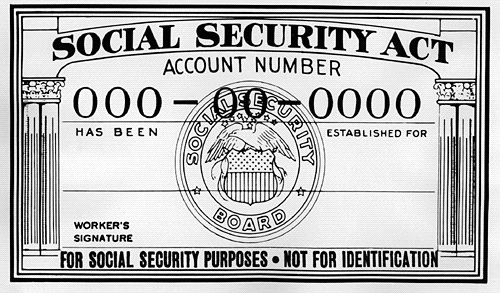
My twitter feed tells me it’s the 82nd anniversary of Social Security. So to mark the occasion, here’s an article that I had written not long ago with the original intent of aiming at trying to get published somewhere (hence, no links). As I haven’t figured out where to submit it to, I’ll post it here as usual instead.
*********************
Not long ago, the Social Security Trustees released the latest Social Security annual report, and reported that the system will begin spending down its trust fund (or “trust fund”, depending on one’s perspective) in 2021, and will exhaust the fund in 2034, at which time only about three-quarters of scheduled benefits will be able to be paid through the remainder of the projection period running through 2090.
Let’s compare this to the equivalent Canadian system’s actuaries’ report, shall we? Their trust fund, throughout the same 75-year projection period, is projected to — well, never be exhausted, under the baseline scenario. Only in the modeling of adverse events were there certain scenarios in which the funds were exhausted, and, in that case, not until 2075 or later.
What’s more, the Canadian system, or, strictly speaking, the Canada Pension Plan or CPP (which covers all of Canada but Quebec), is in such great shape that they’ve actually implemented an enhancement to the program. Benefits will increase by a generous 33%, and, what’s more, their retirement age remains at 65, and this, despite the same sort of demographic worries that plague other countries — Canada, like the U.S., experienced a Baby Boom after World War II, and its Baby Bust was considerably more dramatic than in the U.S., with its current fertility rate (TFR) at only 1.6 children per woman on average.
Does this mean that fears of unsustainability in the U.S. are overblown, and Democratic proposals for expansion are the right way forward? Eh, not so much. The Canadian system is different in several key ways:
The benefits are less generous, and the funding rate relatively higher than our system. Don’t worry, readers: I’m not going to wade through the plans’ valuation details. But consider this: the existing CPP provides benefits of 25% of indexed average pay; Social Security’s benefits are commonly cited as providing 40% of pay for the typical worker. The CPP has a contribution of 4.95% each for the employer and employee, compared to 6.2% for Social Security, in each case including disability and survivors’ benefits. So do the math: for a 25% greater contribution rate, the average American retirees get 60% more generous benefits. It’s not that simple of course — there are a lot of moving parts to both systems, but this is a very simple illustration of the fact that Canada has had more in the way of excess contributions to sack away in their fund.
The system has a flat rate of contributions, and a flat rate of accruals. All Canadians contribute to the CPP on their salary up to the YMPE, or year’s maximum pensionable earnings. And all Canadians accrue benefits at this 25% rate, up to this ceiling. What’s more, the YMPE it not the fairly high wage we’re accustomed to in the United States — it’s set to equal the average annual wage. This means that the system does not depend on high earners subsidizing lower earners as in the U.S., where earnings above bendpoints accrue benefits at lower rates than the earnings below these bendpoints, despite paying in at the same rate. In Canada, everyone pays their own way. This also means that the sustainability also doesn’t depend on these subsidies to lower earners.
Now, lower earners, who are less likely to have had employer pensions, or to have been able to save on their own, are not completely up a creek. In the Canadian system, additional benefits for lower earners are provided through a second, entirely separate system, the Old Age Security (OAS) benefit, which pays a flat benefit to everyone, paid for out of general federal tax revenues, and a third system, the Guaranteed Income Supplement, which pays further benefits for those with low additional income.
This means that these systems can function differently, with different purposes, unlike the American approach of trying to get Social Security to function as both a pay-your-own-way state pension system, and a help-for-the-poor social welfare system simultaneously.
The trust fund is a tangible trust fund, invested in a wide mix of assets. Unlike our “trust fund,” which invests only in special government bonds, the Canadian Pension Plan invests in a wide variety of assets, including private equity and real estate holdings (they fully or partially own Petco, Univision, and Neiman Marcus, for instance). Their long-term planned asset mix is 55% equities, 20% fixed income securities (largely government bonds) and 25% real estate. As a result, its actuarial valuation projects a 3.9% real (above inflation) asset return.
By comparison, the latest Social Security annual report assumes a 2.7% real return since the U.S. the “trust fund” consists solely of government bonds. Despite returns on long-term Treasuries that are barely above inflation at the moment, the actuaries assume that over the 75-year projection period, the rates return to a more “normal” (consistent with increasingly-distant history) higher level.
Experts will haggle over whether these assumptions are reasonable and appropriate, and over how much of a risk premium the Canadians should be expecting for their investments. But besides the greater prospect for earning investment income, the very nature of the Canadian trust fund means that it is a tangibly separate fund the finances of which are wholly independent of the government.
Finally, the benefit enhancement is fully funded. Individuals and employers will pay an additional 1% of pay each, increasing from 4.95% to 5.95%, and the YMPE increases by 14%, with a rate of 4% each for pay between the old and the new ceiling. The math seems a bit odd, since the new piece seems to “cost less” (4% vs. 5.95%), but that’s because the existing contributions are both building up the reserves and paying for retirees who accrued unfunded benefits in past years when they system operated on a pay-as-you-go basis. The contributions for the enhanced portion have been set, based on actuarial modeling, to fully fund the benefit as it’s earned, and no part of the benefit is accrued in advance of the worker making contributions.
Which all adds up to this: the Canucks know there is no free lunch.
In the United States, there have been a number of proposals for enhancements to Social Security. But unlike the fully-funded, pay-your-own-way approach in Canada, politicians have been promising that those enhancements can be made immediately, and can be “free” to recipients, by increasing FICA taxes for the wealthy. So, sure, let’s start discussions on whether and how the American Social Security system should be enhanced. But let’s not imagine that we can do so without cost.
Image: https://www.flickr.com/photos/morbokat/15853636044













